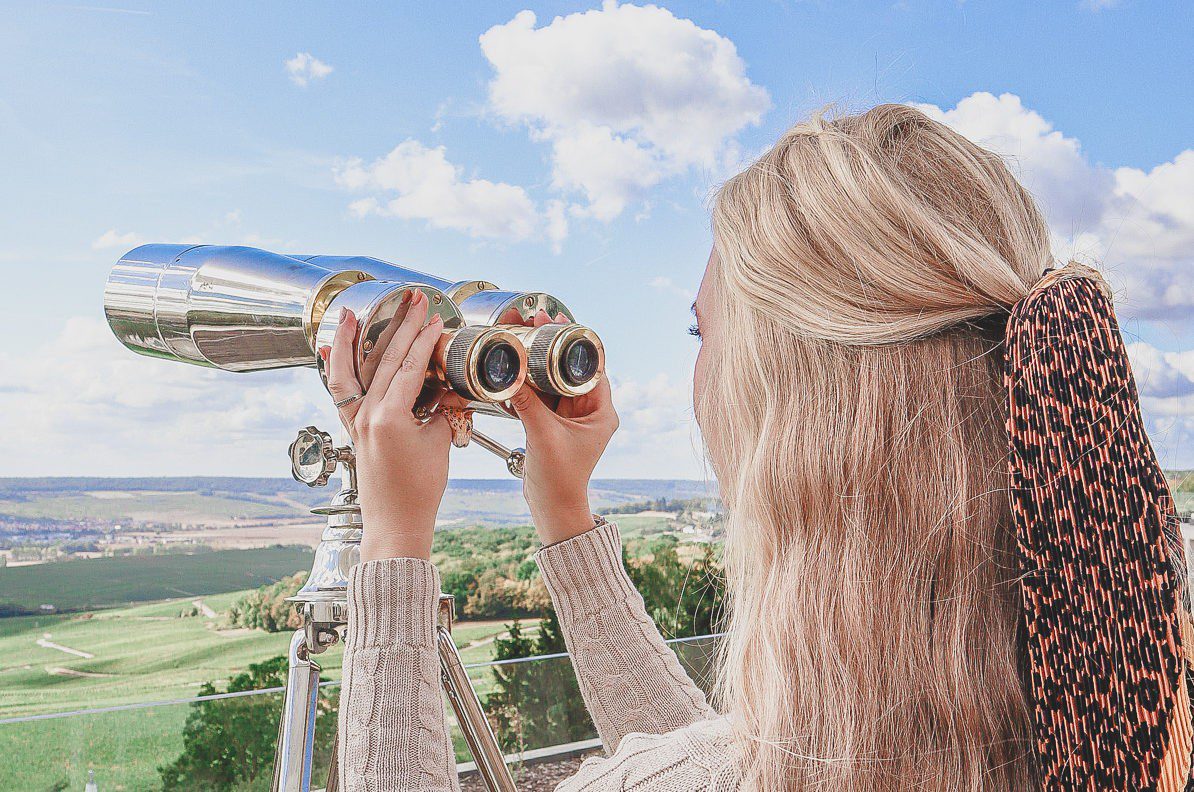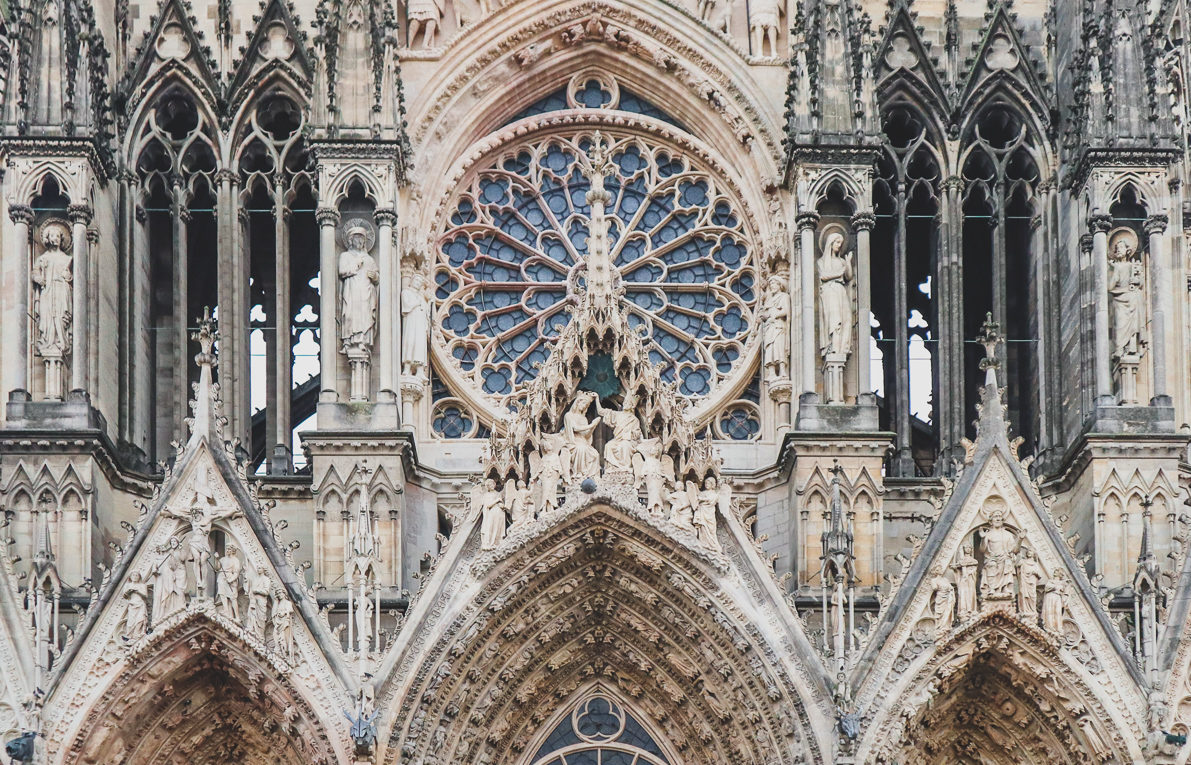I deeply regret that I’m not so well-travelled around France as I’m around the UK or Italy. Obviously, Paris, Loire Valley, Reims, Rouen, Lille… but I’ve always wanted to know France more! It sounds easy – because it takes just a short trip by Eurostar to get to so many French locations – but as it often happens, the easier the journey, the more you postpone opting for more exotic locations.


But now you can imagine my thrill, when I was invited to join an educational trip to Champagne region by Champagne Bureau UK! I definitely cannot squeeze our voyage into one post, so I’m planning to write at least three: trip to Champagne, See Reims in one day and champagne tasting. Let the second part begin!
 |  |
Getting from London
The easiest way to get to Reims is to get the Eurostar train from London St Pancras International to Paris Gare Du Nord and then to change trains at Paris Est. Two French stations are located in an easy walkable distance from each other so I would suggest you to skip ordering a taxi. It might even take longer by car! Besides that, if you have time, you can enjoy a cup of a coffee Parisien in between.

Staying in Reims
Reims is a glorified city in Champagne region famous for its architectural and gourmand insights. It’s a pretty and friendly city with a huge historic background. There are so many amazing spots to see – more in See it in one day: Reims.



Can you imagine that the views on these photos are taken in a hotel? We were staying in the Hôtel de la Paix, a beautiful place just a few minutes from the Reims Central Station almost on the Place d’Erlon and in a several steps from the Fountain Subé.
Admiring architectural treasures of Reims
Absolutely rightfully Reims has been rewarded twice with the title of UNESCO World Heritage Sites: in 1991 for the Cathedral, the Palace of Tau and the old Saint Remi Abbey and, more recently, in 2015, for the Champagne Landscapes. All these important Reims jewels were located pretty close to our hotel. Just a short walk – and I was admiring the morning views of Reims Cathedral. Many of the most important Reims spots are located just a short walk from each other – see more in my post about this sacred city.

Exploring Champagne Houses and Cellars
Of course, Reims is a great place to start learning about the history of Champagne region and champagne as well! You can check 15 facts about champagne too. The history of wine making in Champagne regions counts many centuries, and the love for these kinds of drinks was made even more evident by the royal events happening in Reims – obviously no coronation in Reims Cathedral and the banquet taking place in the Palace of Tau would be a proper feast without a wine drinking!


You have a variety of famous houses to explore its history – just pick you favourite champagne house and go ahead! We were privileged to explore the cellars of Veuve Clicquot with an exclusive tour organised for the Champagne Bureau. Please remember to drink moderately even if you at the seventh sky to be in Reims!
Reims has a reputation of a city to go for the gourmands as well – I can happily confirm that it’s true, just see our mouthwatering dinner at Brasserie Le jardin des Crayères!

Moving out of Reims
If you want to dive into the atmosphere of champagne wines art and crafts, exploring the Unesco listed Champagne region outside of Reims sounds like a great idea! Our tour with the Champagne Bureau UK continued with a nice trip around the area. I’m always left deeply touched by landscapes so undoubtedly I enjoyed views on the lined freshly green vineyards a lot.

A harvest was done just a couple of weeks before our journey and some grapes of the ‘second quality’ were left on the vines. The main grape varieties that are produced in Champagne area are Pinot Noir, Chardonnay and Meunier.


Theory of champagne making
Épernay was our first destination. It’s an ancient town on the Marne river whose main street is called Avenue de Champagne! Sounds like a right place to be, doesn’t it? Our point of visit was La Maison de le Champagne, the sacred place for so many people. In this monumental building resides the Comité Champagne, an organisation established in 1941 that blends the tradition of champagne making with the latest innovations, harmonizing the relationship between the growers, big Champagne Houses and Cooperatives.

We were privileged to learn from the Head of Public Relations for Comité Champagne Philippe Wibrotte about the Champagne region history, champagne wine making and contemporary management of the Champagne production and trade including the economic, ecological and sociological latest updates. By the way, Did you know that the first juridical statement that only a wine produced in Champagne region of France can be called ‘champagne’ dates back to the 1845?

Practice of Champagne testing
Then we moved to another exclusive activity – the champagne tasting – with Helga Barroso, Œnologist Communications Officer. Apart from a quality champagne drinking we discovered how dosage, age, blending of different grape varieties, temperature and glass shape affect the taste, the smell and the color of champagne. More champagne tasting followed that day at the vineyards of one of the local champagne producers in Ecueil, a tiny village near Reims.


Mystery behind the ‘Premier Cru’
I’m sure that you’ve heard about the Premier Cru and Grand Cru? There are 320 cru – or villages – in Champagne. Many of the vine growers don’t make champagne wines themselves and prefer to sell it to the big wine houses. Were we come to the main point: how to set the price of grape based on its characteristics?

Well, the price of grape from the every single cru is determined by the grade it gets in the special classification of grapes – Échelle des Crus, or the ladder of growth. The best, top ranked villages are called Grand crus and the ones whose grade is a bit lower are Premier Cru. There are many other crus as well so stay alert for the highest ranked vineyards!
Dining at the Royal Champagne Hotel and Spa, Champillon
After the educational part came to its end, the more relaxed one took place. We enjoyed a splendid meal at Champillon. The recently opened restaurant Le Bellevue inside the Royal Champagne Hotel and Spa fully committed to its name – the views were astonishing!




I can only applaud to the architect Giovanni Pace who blended so perfectly the renovated building into the nature. Watching the clouds’ shadows come and go over the vines was definitely an experience to remember. I can only imagine how amazing must it be to have this panoramic view for the several days when staying in this hotel.




Truth of champagne making at Hautvillers
Hautvillers, or literally High village, was our next stop during our journey. Located on the hill and surrounded by the vineyards, it’s a small place with cute houses, shops with the Middle-age-like iron shop signs and of course the multiply places to taste champagne!


But the main hotspot of this place is a Benedictine abbey called Abbaye Saint-Pierre d’Hautvillers, or Abbey of Saint Peter of Hautvillers. It was founded in the seventh century: according to a christian legend, a dove showed to Saint Nivard the exact place where an abbey must have been erected.


Abbey of Saint Peter was an important place where the relics of Saint Helena, mother of Constantine the Great, were kept for many centuries. But as soon as the French revolution stroke, the abbey was abandoned. The St Helena relics were also removed and finally were transferred to the Saint-Leu-Saint-Gilles Church in Paris. The abbey has returned to life only in 19th century and now it’s has became a place of pilgrimage for many thankful champagne lovers. Why is that?


Well, the long-standing glory came to this place with a monk called Dom Pierre Pérignon who joined the abbey brotherhood in 1668. He was a cellar master who was keen in innovation. Dom Pérignon was not the one who invented the champagne as many people think but he was the one who contributed a lot to the process of champagne-making, shaping this luxurious drink and creating particular rules on how the vines have to be pruned and the grapes gathered.

Dom Pérignon’s tomb is located in the abbey’s church and always attracts a lot of tourists.
 |  |
Tip: If you are interested in exploring more vineyards, why not try Verzy in Marne area. It’s a charming town where a lot of Champagne houses hold their offices – and just look at these peaceful morning views! This place is also famous for its ‘enchanted forest’ – Foret Domaniale de Verzy.


Hope you enjoyed my today’s blog – and perhaps I’ve managed to tempt you to indulge yourself with a glass of champagne!
Yours.
Anna xxx











1 thought on “Epic trip to Champagne with Champagne Bureau UK”
Pingback: Explore The Beauty Of Reims | Purpurpurpur